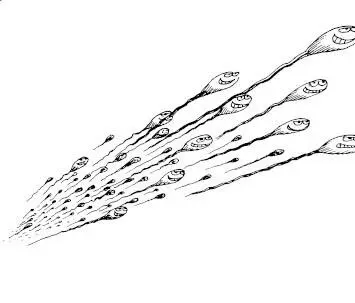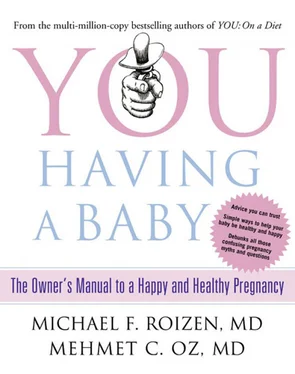
On many tests, you aim to get the highest score possible. This test is a little different. When your Quality of Life score is low (close to 30), your life is in balance.
Trying to maintain your quality-of-life balance during pregnancy is a bit like trying to walk on a four-inch-wide gymnastics balance beam with your pregnant body. It’s not as easy as it looks, and it doesn’t look easy. It is also possible you have not gained enough weight and are overly concerned about your own shape without attending to what your baby may need. If that describes you, see your OB as soon as possible, and perhaps a nutritionist, to make sure you are not underfeeding the baby unintentionally.
So most people are probably not perfectly in balance. Remember that for every gymnast who nails a perfect routine on the balance beam at the Olympics, there are hundreds who slip a little or even fall flat. The trick is just to keep getting up there and trying to balance again.
Interpreting Your Overall Score
30 to 70:Congratulations! You have achieved some real balance in your pregnant life. There’s still a lot ahead of you, but you’re quite centered so far.
71 to 150:Like most pregnant women, there are days when you have it together and days when things seem beyond your grasp. Keep on reading. We have a lot of tips to help keep you centered.
151 to 238:Between your nausea, your inability to think straight, and your negative feelings about your body, you’re probably looking at pregnancy as more like a never-ending traffic jam than an Olympic gymnastics event. All the same, you’re in the middle of one of life’s peak experiences. We have a lot of tips here to make your worst days more bearable. Hang in there, and read on.
* That book is two shelves over.
† In this day and age, of course, traditional intercourse isn’t the only way to make a baby.
* Apologies to anyone named Horatio Horace Humphrey.
Part 1 YOU-ology How Two Became You
1 Nice Genes A New Twist on Genetics Teaches Us How a Baby Really Develops
B ack in tenth-grade biology class, you were probably taught—as were we—that the unique combination of genes you received from your mom and dad (your genotype) was responsible for everything that followed: the color of your eyes, the size of your feet, your love of lasagna, your hatred for all eight-legged and no-legged creatures. To a certain extent, that’s true, but over the past few years, studies have suggested that classical genetics may be only part of the picture. It’s not just your genes that determine who you are, but which of those genes are turned on, or expressed, and to what degree they are expressed—a cutting-edge field called epigenetics. While you can’t control which genes you pass on to your child, you do have some influence over which genes are expressed, affecting what features are seen in your baby (his phenotype). In this chapter, after giving you a brief refresher on the basic biology of what happens after your life-changing evening of romantic rasslin’, we’re going to introduce you to a new subject:YOU-ology—how what you eat, breathe, and even feel can affect the long-term health of your child.
Two to One: The Biology of Conception
We trust that you know the ins and outs of the process that involves his part A and her part B, so we’ll skip what happens deep under the satin sheets and focus on the miracle deep below the flesh and deep inside the body—that is, how the egg and sperm come together. *
Factoid:Though it happens rarely, women who lose their corpus luteum (through a ruptured cyst, for example) might need a progesterone supplement during the first trimester to help maintain the uterine lining until a placenta forms. Other candidates for progesterone supplementation include women who have a history of miscarriages, perimenopausal women, and those having in vitro fertilizations.
On the female side of the conception equation lie her eggs, which are fully formed and stowed away in her ovaries from before birth. Each mature egg contains one copy of each gene in the human genome—half the amount necessary for life. The maximum number of eggs that a woman will ever have is the number she has when she is a twenty-week-old fetus. She’ll have about 7 million of them then, 600,000 when she’s born, and about 400,000 at puberty. Once a woman hits puberty and menstruation begins, her ovaries release one of those eggs every twenty-eight or so days. During each cycle, even though multiple eggs start to develop, hormonal signals ensure that only a single egg will be released and the other eggs will regress. (It’s not wise evolutionarily to blow them all at once, so the body gives females an approximately thirty-year window in which to conceive.) Hormones also work to mature that ready-to-drop egg and to pop a hole in its sac. That hole works as an escape hatch, so the egg can slip out of the ovary and travel down the Fallopian tube, where it may be fertilized by sperm. * Tissue left behind in the ovary after the egg is released, called the corpus luteum, will produce hormones essential to successful pregnancy if the egg is fertilized.
On the other side of the equation, of course, we have those little swimming sperm. As with a woman’s eggs, each sperm contains a single copy of each gene in the human genome. Unlike women, men don’t have a preset number of their reproductive players. In fact, a man produces more sperm in each ejaculation than the total number of eggs that a woman is endowed with for life. (Evolutionarily, a man can continue reproducing for the majority of his adult life, maximizing the chance of passing on his genes. A woman’s reproductive life is limited to the younger years of her life because of the physical strain of pregnancy, childbirth, breast-feeding, and child rearing.)
A man’s sperm, which is carried in semen that’s made by glands such as the prostate, is stored in a duct called the vas deferens. When a man ejaculates, the sperm-carrying semen fires out through the urethra in a seek-and-conquer mission. It may seem that all these millions of sperm are racing one another to the finish. But just like a Tour de France cycling team, the sperm have different roles. Some are deemed the leaders of the pack, trying to be the first to cross the line. Others are designed to assist, specifically by blocking other men’s sperm from making it to the finish line. Competitive little game going on in there, eh? The goal of pregnancy, of course, is for a sperm to find an egg during a precise window of opportunity and fertilize it.

The word imprinting may sound like something you’ve heard on CSI , but it’s actually a form of epigenetics. Even though two copies of a given gene are inherited, one from mom and one from dad, in certain circumstances, one is permanently turned off. The nonexpressed copy is said to be imprinted. As of now, we know of at least eighty genes that are imprinted by epigenetic markers, causing them to be active or inactive in the offspring based on parent of origin. In general, expressed genes that are inherited from the mother conserve maternal resources and limit fetal growth, while expressed genes inherited from the father promote fetal growth, even if it means hurting the mother.
Читать дальше














